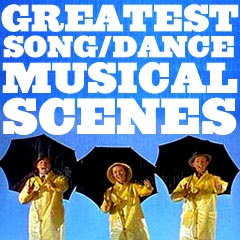
|
|
| S | ||||||
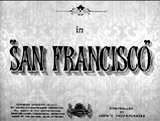
|
San Francisco (1936) Besides the earth-shattering depiction of the SF Earthquake disaster in 1906, Jeanette MacDonald (as Mary Clark) reprised the singing of the title song San Francisco (pictured) - at the annual "Chicken Ball" charity event on behalf of Barbary Coast entrepreneur Blackie Norton's (Clark Gable) Paradise gambling hall to win a $10,000 prize (rejected by Blackie). After the earthquake, she was located on a hillside in a Salvation Army camp singing Nearer My God to Thee (pictured). The Oscar-nominated film concluded with a chorus of The Battle Hymn of the Republic (pictured twice) by the throngs of survivors as they looked down on the devastated city - and imagined its reconstruction (to the reprised tune of San Francisco in the background) in the finale (pictured).
|
 Mary Singing "San Francisco" 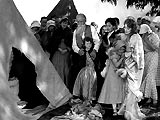 On a Hillside, Mary Sang with the Crowd: "Nearer My God to Thee" |
||||

|
The Sandpiper (1965)
Director Vincente Minnelli's and MGM's romantic drama of illicit love, one of the rare Hollywood films mostly made on location in the Big Sur and Monterey areas of Northern California, starred one of the most notorious real-life couples of all time (it was their third of eleven films together) - the star duo were recently-married in 1964 (after conducting adulterous affairs of their own):
During their association with each other, Laura and Dr. Hewitt began to engage in a passionate extra-marital affair. The film's poster had the tagline: "From the beginning, they knew it was wrong...but nothing could keep them apart!" The tune of the film's Oscar-winning Best Song: The Shadow of Your Smile (pictured) (aka Love Theme from The Sandpiper) (music by Johnny Mandel and lyrics by Paul Francis Webster), was heard during the opening title credits, accompanied by aerial views of the gorgeous California coastline, and performed by trumpet player Jack Sheldon. The film's title, however, referred to a wounded sandpiper bird with a broken wing (pictured) that was tended to by Laura until it was healed and able to fly.
|
 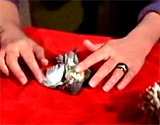
|
||||
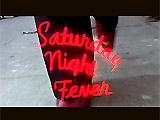
|
Director John Badham's Seventies' disco dance classic opened during the credits with the iconic shot of Saturday night dance king Tony Manero (Oscar-nominated John Travolta) strutting down a Brooklyn street. As the camera panned up his figure, he was revealed as a young stud dressed for the evening with a leather jacket, wide collared bright red shirt and gold chain around his neck, to the tune of the Bee Gee's Stayin' Alive (pictured thrice):
During other dance portions of the film, the main character wore a white polyester suit and strutted his stuff on a pulsating color-tiled dance floor of the 2001 Odyssey club to the songs of the Bee Gees, The Trammps and Yvonne Elliman. Other dance and musical scenes included:
|
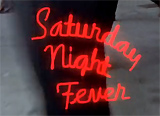 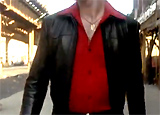 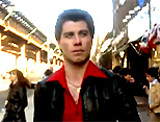 Opening Credits Sequence |
||||
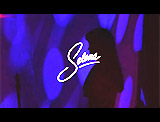
|
Selena (1997) In this romance-drama and musical biopic by director Gregory Nava, Jennifer Lopez starred in a breakout role as Texas-born, Mexican "Tejano" style singer. She recreated the spirit and energetic performances of future Latino superstar Selena Quintanilla-Pérez. The Warner Bros. film concluded with her assassination-shooting death in 1995 by her own crazed fan club president Yolanda Saldívar, at her Corpus Christi, Texas motel, partially seen in a montage. The final sequence was a panning shot from left to right of an empty arena's stage, unattended microphone, and band platform, with Selena's song Dreaming of You (pictured) from 1989 (written by Franne Golde and Tom Snow) playing on the soundtrack. This was followed - during a candlelight vigil - by many actual images (often in split-screen) of the popular 23 year-old singer, ending with a freeze frame of Selena (including dates of her life) (all pictured). |
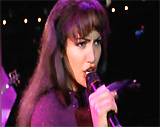 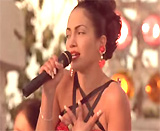  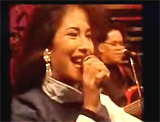 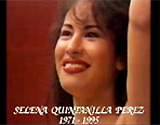
|
||||
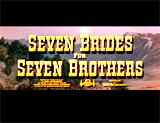
|
Seven Brides for Seven Brothers
(1954) One of the best musicals of the mid-50s was this successful Stanley Donen-directed film from MGM, in CinemaScope, with a Best Picture nomination and an Oscar-winning Musical Score (by Saul Chaplin and Adolph Deutsch). Other nominations included Best Color Cinematography, Best Film Editing, and Best Adapted Screenplay. It featured great Gene de Paul/Johnny Mercer songs in the score, plus incredible dancing segments (although shot entirely on a sound stage with colorful backdrops). The musical was derived from a Stephen Vincent Benet short story titled The Sobbin' Women. Set in the 1850s in the Oregon Territory, it told about the six brothers of Adam Pontipee (Howard Keel) - an Oregon farmer (the eldest of seven brothers), who abducted maidens from town for purposes of marriage. In the early scenes, Adam journeyed to town to buy winter supplies, and spotted the beautiful, hard-working Milly (Jane Powell), who was chopping wood and serving home-made stew to customers at a local boarding house. He sang Bless Your Beautiful Hide (pictured) and decided that they would get married. On the way back to the remote Pontipee farm, she joyfully sang Wonderful, Wonderful Day (pictured) about her married future with him - not knowing that she would be caring for six other brothers as well. After meeting Adam's six unmarried, unruly and rambunctuous brothers (who would eventually be married to six women in the town) and their unkempt house, Milly realized that Adam had married her for her house-keeping skills. Milly took it upon herself to civilize the brothers, and as she sang Goin' Courtin' (pictured) with a polka tune, she taught the boys about the etiquette of courting women. About a month later came the film's highlight - a lively and large-scale dance number. The 8-minute barn-raising dance sequence (pictured) choreographed by Michael Kidd, began with a competitive challenge dance of acrobatic leaps and balletic steps (between the local suitors in town and the Pontipees). Throughout the film, the brothers (with names from A to G) were identified by different colored shirts, while paired up with six women (they also wore different colored dresses in the 'barn-dance' sequence):
The barn-raising was followed by a rowdy fist-fighting brawl (pictured) between the brothers and other jealous suitors in town who were all vying for the attention of the young women.
After the brawling fight in town and the approach of winter, during chore-time, the brothers sang a lamenting lovesick song Lament (I'm a Lonesome Polecat) (pictured) while chopping wood (with rhythmic axe blows and saw strokes). They were lonesome and pining for female companionship. Adam came up with a plan for the brothers. As he lustfully sang Sobbin' Women (pictured), he suggested that they abduct their prospective brides, as the Roman soldiers did when they captured and raped Sabine women (for wives). When their former husbands came to rescue them, they refused to go, and stayed instead with their captors. Following the song, the brothers went to town to kidnap the women, then brought them home (and as they were pursued, they were saved by a snowslide on a mountain pass that blocked the road behind them). When Milly discovered what had happened, she banished the brothers to the barn for the winter and prohibited any more courting. Adam was also a target of Milly's wrath and he was forced to leave for the mountains and exiled for the winter in his hunting cabin. With the arrival of spring, the women were now wishing to get married after a long winter. In the song June Bride (pictured), the various brides in their white underthings were ready to pursue romance. Meanwhile, Milly gave birth to a baby girl. Adam returned, was reunited with Milly and their newborn child Hannah, and was ready to announce that the women would be returned to their families, but the plan was opposed by the brothers - and the women who wanted to stay - they ran off. At the same time, the fathers of the abducted women and their angry suitors arrived, caused a fracas, and threatened to hang the brothers. However, the sounds of Hannah's crying prompted all of the females to claim that the baby was theirs. The Reverend Elcott (Ian Wolfe), Alice's father, conducted a six-way shot-gun wedding ceremony. The film concluded with Spring, Spring, Spring (pictured), a sweethearts' song sung by the brothers and their new brides, in various springtime settings for each of the courting couples. |
 Adam Pontipee (Howard Keel) Singing "Bless Your Beautiful Hide" 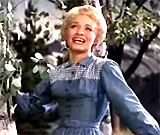 Milly (Jane Powell) Singing "Wonderful, Wonderful Day" 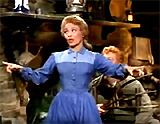 "Goin' Courtin'" - Lessons from Milly 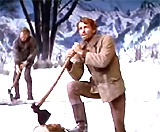 "Lament (I'm a Lonesome Polecat)" 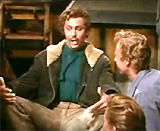 "Sobbin' Women" 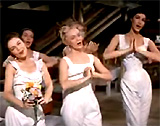 The Kidnapped Women Singing "June Bride" 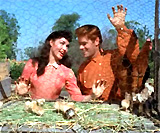 "Spring, Spring, Spring" - a Courting Song |
||||

|
Shaft (1971)
This landmark crime/action blaxploitation film starred Richard Roundtree as the defiantly-proud, ultra-hip, leather-clad, handsome black hero: police detective John Shaft (the black version of Clint Eastwood's "Dirty Harry" Callahan in Dirty Harry (1971)) who worked in Harlem against the Mafia. It was directed by Gordon Parks and would become a major cross-over hit. Shaft had two Academy Award nominations: both for Isaac Hayes - Best Original Dramatic Score, and Best Song. Shaft won an Oscar for Hayes' memorable and stirring theme song, titled Theme From Shaft (proclaiming that Shaft was 'a private dick' who's 'a sex machine to all the chicks'). It was played as an introductory theme song during the opening credits (pictured twice) when the title character emerged from a subway onto NYC's tawdry 42nd Street (first seen in an overhead shot). |
 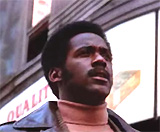
|
||||
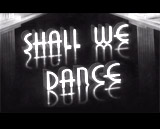
|
Shall We Dance (1937)
This classic RKO film (with an Ira and George Gershwin score), by director Mark Sandrich, marked the seventh pairing of the dancing duo of Fred Astaire and Ginger Rogers (of a total of 10 films). It has been often regarded as the last of their classic string of films together. The film's title lacked a question mark. In the predictable story, touring world-famous American ballet star Peter "Petrov" Peters (Fred Astaire) fell in love - even before meeting her - with Linda Keene (Ginger Rogers), a famous musical revue comedy headliner and tap dancer. In Paris while performing in a Russian dance troupe, Peter browsed through a flip book featuring pictures of Linda (animating her images and making her appear to dance) - and it was love at first sight. Although he hadn't met Linda, he vowed to marry her. The bumbling director of the ballet and Peter's snobbish impresario Jeffrey Baird (Edward Everett Horton) was already upset that Peter was practicing modern jazzy tap dancing on the side instead of ballet. Meanwhile, the termpermental and frustrated Linda told her near-bankrupt producer-manager Arthur Miller (Jerome Cowan) that she was thinking of quitting show business due to numerous fawning amorous advances by many male suitors or dance partners. At the same time, "Petrov" (who wanted it to appear that he was from Moscow by adopting a thick Russian accent) arrived at an inopportune moment at her apartment to introduce himself to her, but she was unimpressed by his arrogance. The two ended up on the same ship back to the US. One of the film's ongoing misunderstandings was a false rumor perpetrated by Jeffrey that Peter had been secretly married for four years to ex-ballerina Lady Denise Tarrington (Ketti Gallian), one of his persistent admirers. On board the ship, to rid himself of Lady Tarrington, Peter confirmed the rumor. While sailing on board the ship to NY, Peter and Linda became very well acquainted while strolling with their dogs on deck, leading to the assumption that Peter was married to Linda and that she was pregnant. Linda became outraged and very upset that Peter had used the rumor to get close to her on the ship and to avoid Lady Tarrington. She persuaded the pilot of the mail plane to the ship to take her with him on his return flight to NYC. Once in NY, Linda announced that she was indeed single, and that she had decided to marry a Park Avenue socialite, Jim Montgomery (William Brisbane). Linda's manager Arthur planned a farewell dinner for them in a NYC hotel's rooftop nightclub, as a way to sabotage her marital plans by managing to have her dance with Peter. The two danced "They All Laughed" beautifully together to an appreciative audience. However, Arthur remained determined to keep Linda from marrying Jim, by reviving the false rumor. Many still believed that they were married after Arthur staged and publicized a photograph of Linda (a life-sized mannequin model) and Peter sleeping together as a married couple. To hide from reporters who wanted to interview them about their 'marriage,' Peter and Linda retreated to Central Park for rowing and roller-skating. She finally suggested a solution to their problem - she would marry him so that she could then promptly divorce him. The two had a quickie marriage in New Jersey, and then returned to New York on the ferry. At first, Linda believed that the marriage was depressing, cueing up Peter's singing of a ballad "They Can't Take That Away From Me" on the ferry to lighten her mood. Soon after, Linda began to have affectionate and loving feelings for Peter. However, another romantic twist entered - in NY after Linda found Peter with trouble-making Lady Tarrington in their hotel, she decided to pack her bags, stormed out, and initiated divorce proceedings. Peter turned disconsolate after their scandalous breakup, and after learning that his opera-house show with the Metropolitan Balley Company had been cancelled. To help the desperate Peter, Arthur offered to feature him in his upcoming musical revue at his nightclub's roof garden. The film's happy ending was concluded with the title number "Shall We Dance" featuring Peter dancing with dozens of chorus girls (with multiple 'Linda' masks - an idea copied from Dames (1934)) and solo dancing with Linda herself. Although Linda arrived to serve him divorce papers, she softened when she saw Peter dancing with a chorus of dancers wearing Linda masks, and realized that their love was real. Linda changed into one of the matching dancing costumes (with a mask), joined the chorus onstage, and then after being unmasked, she danced with Peter as they were reunited. This film included many of their most famous numbers:
|
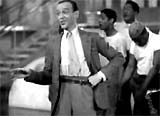 In the Ocean Liner's Boiler Room - a Song and Tap Dance: "Slap That Bass"  Song: "Beginner's Luck" on Deck of Ship 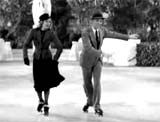 Central Park Roller Skating: "Let's Call the Whole Thing Off" 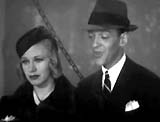 After Their Marriage: "They Can't Take That Away From Me" 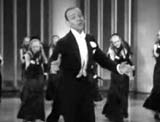 Title Number in Film's Conclusion: "Shall We Dance" |
||||
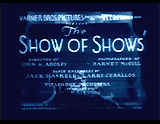
|
The Show of Shows (1929) Here was one of the first "variety" revue shows, featuring "all-talking, all singing, and all dancing" vaudeville dramatic acts and songs from dozens of Warners' stars and hosted by Master of Ceremonies emcee Frank Fay. This was originally a two-color Technicolored film, but now available as mostly black and white. The many numbers included:
In the lavish Lady Luck finale (pictured), Betty Compson and Alexander Gray starred along with 15 individual acts. The number was climaxed by each of the film's stars poking their heads through holes in a huge canvas drape (with a star design), and singing Lady Luck before the curtain closed on them. |
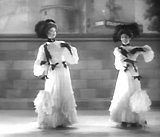 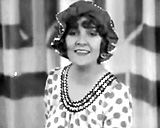 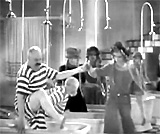 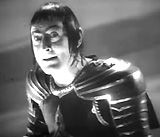 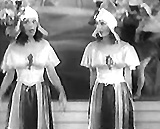 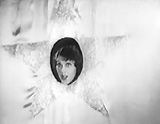
|
||||
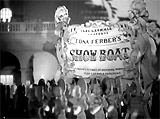
|
Show Boat (1936)
This black and white 1936 film from Universal and directed by horror film master James Whale, often considered the definitive version of the material, was the best stage-to-film adaptation of the popular, long-running 1927 Broadway hit musical (by Jerome Kern and Oscar Hammerstein II) that was revived in 1932. It was derived from Edna Ferber's 1926 source novel about Cap'n Andy Hawks' showboat Cotton Blossom. There were three film versions of the musical from 1929 to 1951:
In addition to nine songs retained from the 1927/1932 stage show, three new songs were added to the 1936 film:
Three of the more notable Jerome Kern numbers were:
|
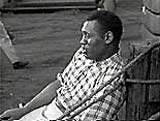 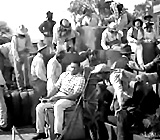 'Ol Man River' in 1936 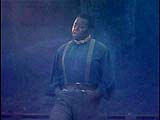 'Ol Man River' in 1951  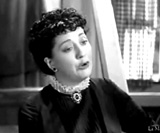 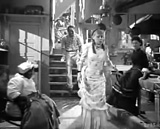
|
||||
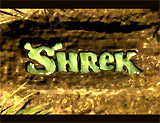
|
This computer-generated animation PDI/DreamWorks production, winner of the Best Animated Feature Film Oscar (in the first year that the new awards category was introduced). It featured parodies of well-known fairy tales, characters, and Disney and Disneyland-related items and popular films (Snow White, the Wicked Witch, Cinderella, Robin Hood - or Monsieur Hood, The Matrix, etc.), and included pop songs in its soundtrack. After the marriage of green ogre Shrek (voice of Michael Myers) and Princess Fiona (voice of Cameron Diaz) and their departure in the storybook ending, the animation ended with the celebratory song-and-dance number I'm a Believer (Neil Diamond's song, performed by Smash Mouth) sung by Donkey (voice of Eddie Murphy) (pictured) with the entire cast of fairytale creatures dancing in their own unique styles:
The DVD release included an additional three-minute segment of the film's I'm a Believer musical finale. |
 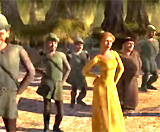 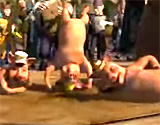
|
||||

|
In this sequel, after green ogre Shrek (voice of Mike Myers) and Princess Fiona (voice of Cameron Diaz) had been married, they returned to Far, Far Away land, ruled by their shocked in-laws: King Harold (voice of John Cleese) and Queen Lillian (voice of Julie Andrews). The film's Oscar-nominated Best Original Song Accidentally In Love (pictured), sung by Counting Crows, played over scenes of Shrek and Fiona's honeymoon. Memorable numbers also included two show-stoppers:
Another celebratory song-and-dance ensemble number was in the closing, Ricky Martin's Livin' La Vida Loca (pictured), sung by Donkey (voice of Eddie Murphy) and ogre-killer Puss-In-Boots (voice of Antonio Banderas). [Note: The DVD release featured an American Idol spoof called "Far Far Away Idol", with Simon Cowell (as Himself) judging the film's characters.] |
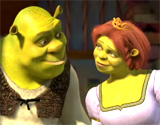 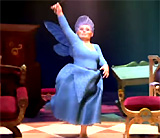 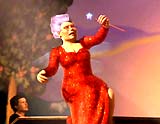 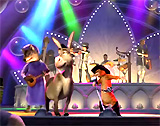
|
||||
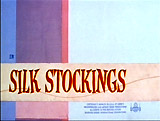
|
Silk Stockings (1957) Director Rouben Mamoulian's screen dance-musical (his last film) was a widescreen MGM musical remake during the Cold War era of Ernst Lubitsch's classic comedy Ninotchka (1939) with Greta Garbo, and adapted from Cole Porter's last Broadway show. It also marked 57 year-old Fred Astaire's last musical film for 10 years, and was famed Arthur Freed's first film as an independent producer at the studio. Cyd Charisse took the role of conservative Soviet spy Ninotchka Yoschenko (sent to Paris to bring back a defector) who was engaged in May-December romance with Fred Astaire (as Hollywood movie producer Steve Canfield in Paris making a film) - it was the pair's first onscreen teaming since The Band Wagon (1953). Memorable of the thirteen Cole Porter tunes were:
|
 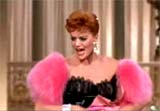 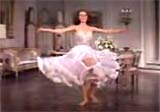 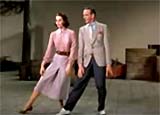  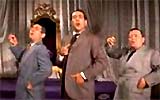
|
||||
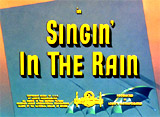
|
This MGM classic, co-directed by star Gene Kelly and Stanley Donen, featured an original story (a spoof set in the late 1920s during the age of the coming of 'talkies') by Betty Comden and Adolph Green, with a screenplay using songs from Arthur Freed and Nacio Herb Brown. It had only two unrewarded Oscar nominations: Best Score (Lennie Hayton) and Best Supporting Actress (Jean Hagen). This film's title scene (performed first in the opening title sequence) has been considered part of movie legend - as the most famous solo song-and-dance signature number in film history - it featured Gene Kelly singing the title song Singin' In the Rain (pictured) in a downpour, swinging his umbrella around, deliberately stomping in puddles, and leaping onto a lamp-post.
Also, the opening credits rendition of the title song was performed by a trio of cast members wearing yellow raincoats and sporting umbrellas (pictured):
The trio later sang the popular song Good Mornin' (pictured) in a living room. Reynolds participated in a fabulous love duet/dance You Were Meant For Me (pictured) on a deserted sound stage with Kelly, and O'Connor performed the unforgettable acrobatic, comical and slapstick song-and-dance routine Make 'Em Laugh (pictured). The film was also highlighted by the satirical song-and-dance Moses Supposes (pictured) by Kelly and O'Connor in which they rebelled against their diction coach (Bobby Watson) as well as their song-and-dance Fit As a Fiddle (pictured). Kelly and gangster's vampish moll Cyd Charisse (in her first teaming with Kelly) memorably danced in the climactic Broadway Rhythm Ballet (pictured), and the finale song was You Are My Lucky Star (pictured). |
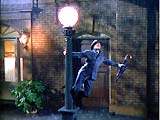 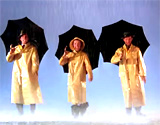 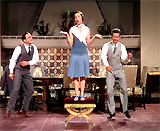 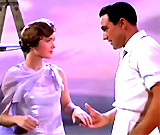 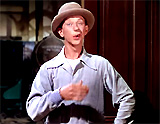 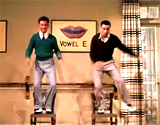 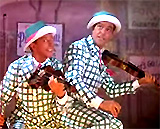 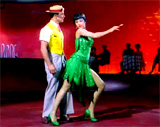 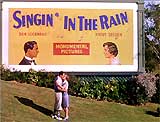
|
||||
(alphabetical by film title) Introduction | A-1 | A-2 | B-1 | B-2 | B-3 | C-1 | C-2 | D-1 | D-2 | E | F-1 | F-2 | G-1 | G-2 H-1 | H-2 | I-J | K | L-1 | L-2 | M-1 | M-2 | N-O | P-1 | P-2 | R-1 | R-2 | S-1 | S-2 | S-3 | T | U-V | W | X-Z |